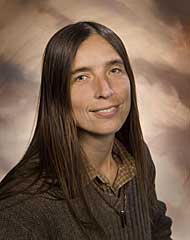Report on GHP11
August 15, 2011

Ramona Vogt
By Ramona Vogt, LLNL and UC Davis
The units of the American Physical Society provide opportunities for members to interact with colleagues with similar interests and to keep abreast of new developments in their specialized fields. One such unit is the APS Topical Group on Hadronic Physics, see this previous story for more information about the GHP.
The mission of the GHP is the advancement and diffusion of knowledge related to QCD and hadronic physics. The hadronic physics community is fairly diverse and includes physicists working on spectroscopy, lattice gauge theory, nucleon structure physics (structure functions and spin), jet physics, heavy-ion physics, and QCD at finite temperature and density.
The executive committee currently consists of Ronald Gilman (Rutgers), chair; Ramona Vogt (LLNL and UC Davis) chair elect; John Arrington (ANL) vice chair; Stanley Brodsky (Stanford), past chair; Craig Roberts (ANL) secretary/treasurer; and two members-at-large, Robert Edwards (JLab) and Volker Crede (Florida State). RHIC physicists not already members of the GHP should consider joining and make their presence felt. The GHP web page can be found at http://www.aps.org/units/ghp/.
This spring the GHP established a Dissertation Award in Hadronic Physics to recognize the outstanding accomplishments of talented young scientists in our field, with support from Brookhaven National Laboratory and Jefferson Science Associates.
For more information about the award, go to: http://www.aps.org/programs/honors/dissertation/hadronic.cfm. The first award is expected to given in time for the next biennial meeting of the GHP in 2013. However, some funds are still required to fully endow the award. If you wish to contribute, please go to the online donation web page.

GHP11 Workshop Participants (Photo courtesy of Kandice Carter, JLab)
The fourth GHP workshop, GHP11, was April 27-29 in Anaheim, CA, just before the April 2011 APS meeting and consisted of plenary and parallel sessions. The meeting was co-chaired by Ron Gilman and Ramona Vogt. The organizing committee consisted of the current members of the GHP executive as well as external members Abhay Deshpande (Stony Brook), Cheung Ji (North Carolina State), Peter Petreczky (BNL), Sevil Salur (UC Davis and Rutgers), Susan Schadmand (FZ-Juelich), and Karl Slifer (University of New Hampshire). The program, with links to the abstracts and talks, can be found on the workshop web page, ably maintained by webmaster Susan Schadmand.
Thanks to the enthusiasm of the members of the RHIC community on the organizing committee, there were a record number of high-energy heavy-ion talks, including a full parallel program on heavy-ions and spin (six sessions). There were sessions on experimental results on heavy flavor and quarkonium, jets, and hadronic observables. First results from the LHC collaborations were presented including the first observation of Z0 production in Pb+Pb collisions (CMS); J/psi suppression (ATLAS); and low-mass hadronic observables (ALICE). Talks on recent RHIC results included production of anti-helium, high pT processes and jets and quarkonium. A parallel session was dedicated to the proposed electron-ion collider with talks on nucleon structure studies, e+A physics possibilities, as well as studies of QCD and hadronization at the EIC. Theory talks focused on hydrodynamic modeling and lattice results.
RHIC-related plenary talks were given by Jamie Dunlop (STAR, BNL) on heavy flavor at RHIC; Alexei Bazavov (BNL) on lattice progress; Michael Strickland (Gettsyburg College) on quark-gluon plasma theory; Ming Liu (LANL) on Drell-Yan physics; Julia Velkovska (Vanderbilt) on first LHC results; Marco Stratmann (BNL) on EIC opportunities; and Steve Vigdor (BNL) on the future of RHIC from near-term upgrades to the decadal plans. In addition, the summary talk by Al Mueller (Columbia) included a lengthy discussion of gluon saturation.
There were also lively discussions on AdS/QCD (Carl Carlson, William and Mary), the proton size (Gerry Miller, U Washington), condensates (Peter Tandy, Kent State), light meson spectroscopy (Josef Dudek, JLab) and the JLab 12 GeV upgrade (Bob McKeown, JLab). Other parallel sessions focused on lattice studies of mesons and nucleons; the spin structure of the proton; quarkonium and light hadron spectroscopy; strangeness in the nucleon; nucleon structure (various types of parton densities and form factors); photoproduction and future facilities.
GHP11 saw the largest participation by the heavy-ion community at a GHP workshop thus far, with about 30% of the talks on heavy-ion related topics. We hope to continue to grow the GHP, and the portion of membership from the high-energy heavy-ion community, by attracting interested physicists to the group.
2011-2553 | INT/EXT | Newsroom









